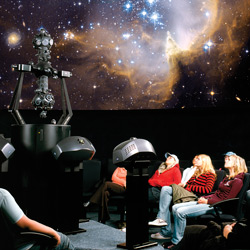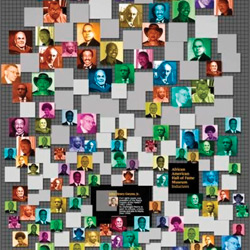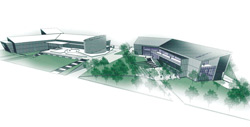
"To inspire lifelong learning for all, connecting art, history, science and achievement through collections, exhibitions and programs."
—Mission of the Peoria Riverfront Museum
Every day, museums of all kinds work to preserve and protect our historic and cultural heritage and engage the community in lifelong learning. When it comes to tourism, museums are significant destination drivers, ranking among the top three family vacation destinations. According to the American Association of Museums, there are more than 850 million visits to American museums each year, more than the attendance of all professional sporting events and theme parks combined.
On October 20, 2012, one of the largest developments in Peoria’s history will come to life when the Peoria Riverfront Museum opens its doors to the public for the first time. Among its 86,000 square feet will be exhibits devoted to the Illinois River, Peoria-area history, IHSA sports, the fine arts and folk art, not to mention the planetarium, giant-screen theater and traveling exhibitions from the Smithsonian Institution. More than 350,000 visitors are expected each year, with a regional economic impact of $7 to $14 million.
It’s a one-of-a-kind collaboration that has taken years to come to fruition. The PRM’s partner organizations include Lakeview Museum of Arts & Sciences, Peoria Historical Society, African American Hall of Fame Museum, Illinois High School Association, Peoria Regional Museum Society, Heartland Foundation, Caterpillar Inc., Peoria County and the City of Peoria.
 What will be in the Peoria Riverfront Museum?
What will be in the Peoria Riverfront Museum?
- International Features Gallery. For international traveling exhibits, including those from the Smithsonian Institution.
- PowerDome Digital Planetarium. Features a cutting-edge system that is the first of its kind in the Western Hemisphere.
- Giant Screen Digital Theater. A digital 3D theater with a 52' x 70' screen—that’s over five stories tall!
- Illinois River Encounter. Presents the fascinating story of the Illinois River and its complex ecosystem, of which humans have long been a part.
- IHSA Peak Performance Center. A high-energy experience that presents and tests the many skills required of participants in the IHSA's 39 sports and activities.
- The Street. A dramatic gallery of changing exhibits designed to immerse visitors in more than 300 years of Peoria history. The Street will include a hands-on area, a Wall of Fame that recognizes inductees to the African American Hall of Fame, an Oral History Center and an Object Theater.
- Discovery Worlds. Two galleries filled with unique hands-on activities, including a Splash Zone for children of all ages.
- Fine Arts & Folk Art Gallery. A gallery that permanently showcases the museum's expansive collection of fine and folk arts, including visitor favorites like the Frank Lloyd Wright chair and the Rodin sculpture.
America’s Museum in Peoria
With 137 million artifacts, works of art, objects and specimens in its permanent collection, it’s not possible for the Smithsonian Institution to display everything at one time. That’s why “America’s Museum” began its affiliate program back in 2000—so these items would not languish in storage back in Washington, D.C., but could instead be sent to regional museums across the country.
 Lakeview Museum—one of the oldest Smithsonian affiliates and among just five in the state—began its affiliation that very first year, in 2000. With its larger footprint, the new Peoria Riverfront Museum will be able to expand its Smithsonian offerings, allowing for exhibits that might previously have been turned down or scaled back for lack of space.
Lakeview Museum—one of the oldest Smithsonian affiliates and among just five in the state—began its affiliation that very first year, in 2000. With its larger footprint, the new Peoria Riverfront Museum will be able to expand its Smithsonian offerings, allowing for exhibits that might previously have been turned down or scaled back for lack of space.
“The current exhibit is a perfect example,” notes Kate Schureman, vice president of administration at Lakeview. “We were able to bring the Jim Henson exhibit to Peoria, but it is a smaller version. We have had to pass on other exhibits because we simply have not had the physical space. A Star Wars exhibit comes to mind, as well as exhibits on the First Ladies and the Presidency.”
Perhaps we will someday see Luke Skywalker in Peoria, then, after all!

Interactivity and Play in the Digital Age
Just a small percentage of what we learn in the course of our lives takes place in formal learning settings—schools, universities, professional development seminars and the like. The majority of our learning occurs in informal and less structured settings…like museums. With its interdisciplinary and playful approach to learning, the Peoria Riverfront Museum will be an ideal stage for lifelong learning in central Illinois.
“Our mission has always been about lifelong learning,” explains Kate Schureman, vice president of administration at Lakeview Museum, “and with the new facility, we have greater opportunities to serve more ages—and on a larger scale.”
With its focus on both the arts and the sciences, Lakeview Museum has employed an interdisciplinary approach since it opened its doors in 1965. A variety of studies indicate that children with exposure to the arts also do better in the STEM disciplines (science, technology, engineering and math) that are being emphasized in schools today. “We’re finding that kids at the intersection of arts and sciences actually do better on their test scores because of the influence of the arts in their lives,” adds Schureman. “A lot of the ways that we think and process information about the arts actually enhances how we process information when we try to figure out a physics or algebra problem.”
The concept of play also figures prominently in the museum’s approach, and promises to make learning fun again. “Kids don’t play anymore,” laments Nikki Cole, the museum’s vice president of development. “So much time at school is devoted to learning for the test…in their minds, that is learning.” Coupled with the rise of Facebook and texting—and the tendency of well-meaning parents to overprogram their children’s schedules—many of today’s kids are missing out on this critical aspect of development.
“To older generations, it may seem odd that you have to go somewhere else to play with Legos or to fingerpaint, but kids just aren’t doing those things as much anymore,” says Cole. “When we talk to visitors and kids, that’s what they want to come to a museum to do! They want to play with other kids. They want to build things and have a chance to make art.”
In the new museum, history will become more than just text and dates—it will be a hands-on, interactive experience. “The kids might learn about all of these wonderful things that have happened in Peoria, and then they’ll go into the hands-on area and be able to play with one of the bulldozers from Cat that they just learned about,” explains Cole. “So we’re pulling in those elements of play and learning into other disciplines.”
And contrary to widespread perceptions, “interactive” does not necessarily imply computer screens or buttons. “Today, everything that kids do is on a screen or involves pushing a button,” says Cole. “That’s not interactive or fun for them. They don’t perceive it in the same way that previous generations did—it’s work to them.” In today’s world, the concept of “interactive” has come full circle. Today, “interactive” is about play. It can be as simple as fingerpainting or making paper origami shapes with other children.
“In the digital age, ‘interactive’ can also be about seeing the actual item,” adds Schureman, “which gets back to why museums first started—to maintain and preserve these important objects.” As the world becomes more virtual, these tangible objects actually become more important, even with digital access to them. While one can pull up an image of the Mona Lisa online and learn everything about it, there is no substitute for seeing the portrait in person.
Create, discover, explore, achieve—these are the four words that Schureman and Cole use to encapsulate the learning experience at the new Peoria Riverfront Museum. “It doesn’t matter what your background is…your socioeconomic status or your age, this is a place for everyone to do those four things," says Schureman. “That’s what lifelong learning is all about.”
Built for Change
From the beginning, the Peoria Riverfront Museum was planned with the idea that its exhibits would change on a regular basis. While the building shell will change very little over time, its exhibits, programs and presentations will be transformed every four to 48 months. It’s known as the delta model, in reference to the Greek letter used to denote change.
“The Delta Museum is an institution built for change,” explained Jim Richerson, the museum’s president and CEO. “It is a model that one finds in theaters, retail stores, libraries and sports arenas.”
Under the delta model, flexibility is fundamental and key to planning for museum staff. Regularly changing exhibits will help to heighten visitor expectations and bring them back for return visits. “Essentially, we train the community to expect change,” adds Richerson. iBi

